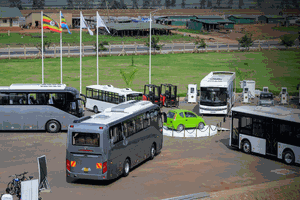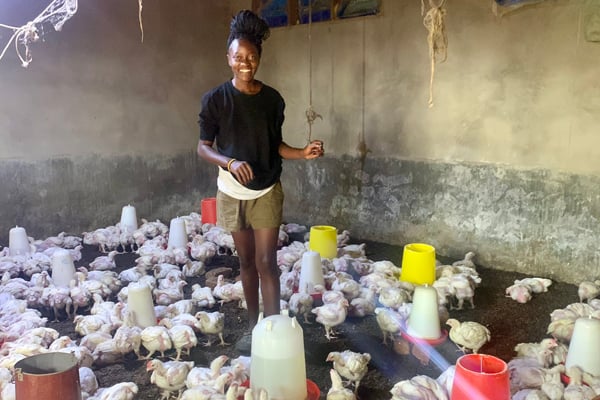Prime
Bwaise satellite terminal to decongest city takes shape

A view of of the Bwaise Transit Terminal in Kawempe Division in Kampala on Tuesday. PHOTOS/SYLIVIA KATUSHABE.
What you need to know:
The Bwaise Transit Terminal is belted to the south by the Northern Bypass, to which it connects, offering what its planners envisage to be seamless entry and exit for vehicles.
Fifteen years ago, City Hall unveiled the Greater Kampala Metropolitan Area master plan which, among others, sought to decongest the inner-city through establishment of satellite bus/taxi terminals in the outskirts.
By the blueprint, the terminals at Bwaise, Banda and Nateete were to be built under a public-private partnership (PPP) arrangement, meaning private investors and government entities would jointly pick bills of the developments.
The administration of former Kampala Capital City Authority (KCCA) Executive Director Jennifer Musisi, appeared enthused with the idea of the project baptised Bus Rapid Transport (BRT).
Under the plan, buses, long-haul trucks and 14-seater commuter taxis would terminate trips at a transit hub outside the Central Business District (CBD), or bypass the CBD through ring roads.
Ms Musisi’s administration even announced that the inner-city would then be serviced by trams, passenger trains and cable cars.
It is now 180 months 15 years envisaged for implementation of the projects.
But there are no tram tracks on the ground, no overhead loops or powered haulage ropes to shuttle the cable cars back-and-forth, while only one of the many planned satellite bus/taxi terminal is taking shape - in the northern Bwaise suburb - and without government investment.
Sandwiched between Bombo Road, which connects to northern Uganda, and Mambule Road, the Bwaise Transit Terminal is belted to the south by the Northern Bypass, to which it connects, offering what its planners envisage to be seamless entry and exit for vehicles.
Col (rtd) Fred Bogere, the director of Kampala Logistical Centre Investment Limited (Kalocen) which is developing the park, said the works are 65 percent complete and a dry run is planned for Monday ahead of official opening of the transit hub next month.
“We have put water on site, electricity and shops are available, some people have already booked and are waiting for customers,” he said on a site visit with political leaders of the city’s Kawempe Division where the project is situated.
Located on an 8.5-acre land, acquired and titled incrementally from private owners, the terminal, which is roughly 5kms north of the city centre, has 700 parking slots for commuter taxis, but can handle 2,000 transiting ones per day, in addition to 100 buses and 40 trucks.
The park, which is intertwined with wholesale stores, lock-up shops and other social amenities, will create 15,000 jobs for traders and transporters, according to Col Bogere, who said they have so far invested Shs12.7b.
They immediately need Shs3.5b of an additional Shs10b, money which Kawempe Division Mayor Emmanuel Sserunjogi, who visited to assess progress of the works, said the government should provide or source from third parties such as the World Bank.
“We call upon the government to come in and assist the company because this is a big project that will solve some of the problems [that] even the central government is facing and from day one, it is going to start collecting tax from here,” Mr Serunjogi said.

Col (rtd) Fred Bogere (pointing), the director of Kampala Logistical Centre Investment Limited, guides Kawempe Division Mayor Emmanuel Sserunjogi (3rd left) and Division leaders as they inspect the park on Tuesday.
Once in operation, the terminal will principally serve vehicular traffic on northern and mid-western routes and provide access to the Northern Bypass, which links routes east and west of Kampala. The progress registered so far has not been without hurdles: from acquisition, consolidation and titling of fragmented land to opposition by transport and other stakeholders worried that the project would upend their fortunes, as well as slum dwellers resisting displacement and relocation.
It is, therefore, unsurprising that Mr Suleiman Walugembe, the Kawempe deputy resident city commissioner (DRCC), while appreciating the development, urged leaders in the division to put their differences aside and support the project.
“We shall help in getting leadership of the [bus/taxi] park and ensure we work with the Federation of Uganda Taxi Operators so that they can supervise us because taxi leadership is under their control,” Mr Walugembe said, asking the transit terminal management to give first opportunity for jobs to Kawempe residents.
The deputy RCC said his office will work together with the mayor and town clerk to support and guide the investment.
Leaders and residents neighbouring the park are upbeat about its dividends.
Mr Puna Bossa, the Local Council 1 general secretary for Mayinja Zone where the works are ongoing, told this newspaper that security in the area has already improved even before the transport hub is operational.
He said the project site used to be a lair for criminals --- thieves, robbers, drug abusers, sex pests and burglars --- and the demolition of the crammed improvised houses has denied them hide-outs.
Mr Bossa said they would each day register at least two criminal complaints from residents of the portion of the slum taken by the project, which is no more.
“Thieves would hide there, steal from women going to Kalerwe market for shopping, but now that has stopped because the place is open and no thief runs in the open,” he said.
Mr Bossa also noted that the project has already changed the face and skyline of Bwaise, contributing to a “smart city”.
“If you had passed here 10 years ago, this used to be a slum area, but now that we have good structures, it is a contribution to a smart city,” he said.
Mr Ronald Wamala, a taxi driver on the Luweero route, welcomed the establishment of the new park, saying it will help them have a place to settle.
“We have been operating along the road, and the taxi takes time to get full because we are not orderly and most times customers find it hard to [decide which vehicle to board],” he said.
Ms Annet Nasimba, a business woman neighbouring the transit terminal, said opening the park will boost businesses in the community because it consolidates services and brings together many people from different places in one location.
“Business runs well in places with many businesses and many people, because it is easy to buy what one doesn’t have from within rather than investing in transport to go and shop from the city [centre],” she said.
Col Bogere, the developer, asked the government to do more and support the Bwaise Transit Terminal.
“This was supposed to be a public–private partnership, but ever since we won these tenders, the government has not put in anything and it is not coming in to help,” he said.
Yet, he added, the new transport hub presents a free-pass remedy to all “decongesting efforts by relocating heavy demographic facilities to the outskirts of the CBD”, thus, easing the movement of persons and goods.



